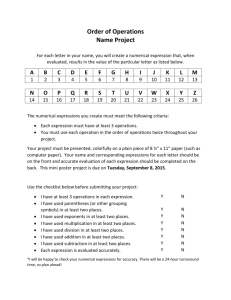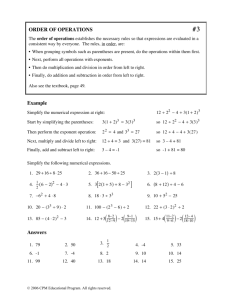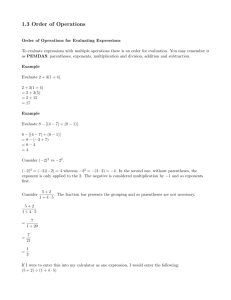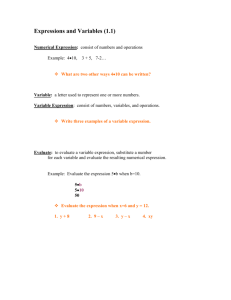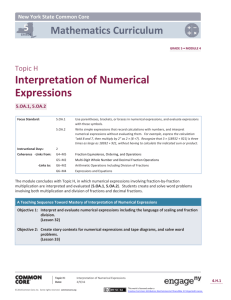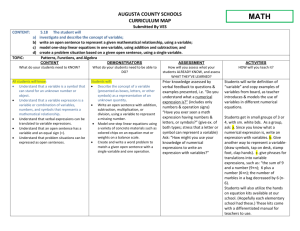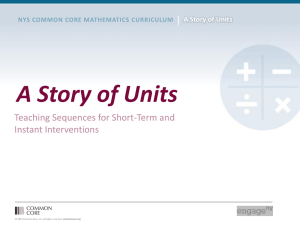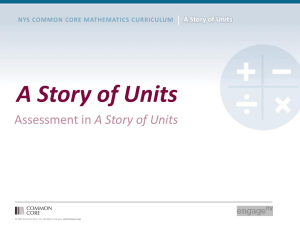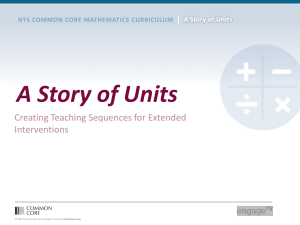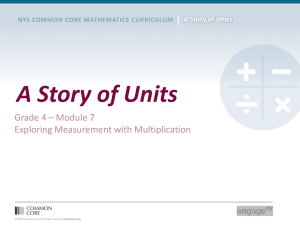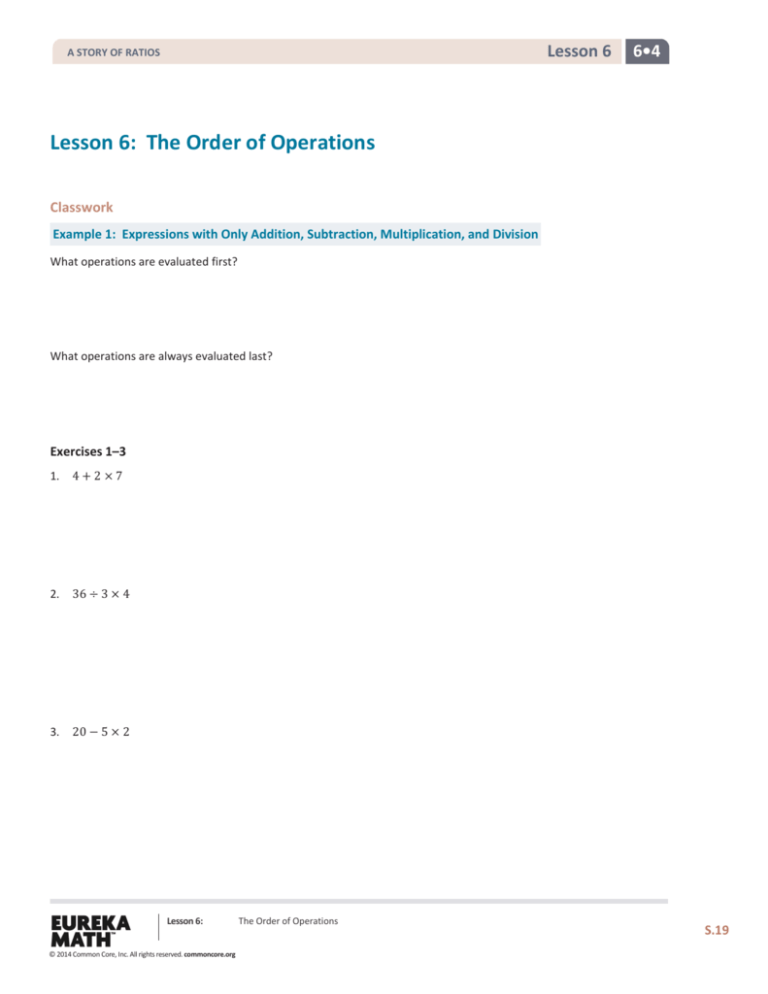
Lesson 6
A STORY OF RATIOS
6•4
Lesson 6: The Order of Operations
Classwork
Example 1: Expressions with Only Addition, Subtraction, Multiplication, and Division
What operations are evaluated first?
What operations are always evaluated last?
Exercises 1–3
1.
4+2×7
2.
36 ÷ 3 × 4
3.
20 − 5 × 2
Lesson 6:
© 2014 Common Core, Inc. All rights reserved. commoncore.org
The Order of Operations
S.19
Lesson 6
A STORY OF RATIOS
6•4
Example 2: Expressions with Four Operations and Exponents
4 + 92 ÷ 3 × 2 − 2
What operation is evaluated first?
What operations are evaluated next?
What operations are always evaluated last?
What is the final answer?
Exercises 4–5
4.
90 − 52 × 3
5.
43 + 2 × 8
Lesson 6:
© 2014 Common Core, Inc. All rights reserved. commoncore.org
The Order of Operations
S.20
Lesson 6
A STORY OF RATIOS
6•4
Example 3: Expressions with Parentheses
Consider a family of 4 that goes to a soccer game. Tickets are $5.00 each. The mom also buys a soft drink for $2.00.
How would you write this expression?
How much will this outing cost?
Consider a different scenario: The same family goes to the game as before, but each of the family members wants a
drink. How would you write this expression?
Why would you add the 5 and 2 first?
How much will this outing cost?
How many groups are there?
Lesson 6:
© 2014 Common Core, Inc. All rights reserved. commoncore.org
The Order of Operations
S.21
Lesson 6
A STORY OF RATIOS
6•4
What is each group comprised of?
Exercises 6–7
6.
2 + (92 − 4)
7.
2 ∙ �13 + 5 − 14 ÷ (3 + 4)�
Example 4: Expressions with Parentheses and Exponents
2 × (3 + 42 )
Which value will we evaluate first within the parentheses? Evaluate.
Evaluate the rest of the expression.
Lesson 6:
© 2014 Common Core, Inc. All rights reserved. commoncore.org
The Order of Operations
S.22
Lesson 6
A STORY OF RATIOS
6•4
What do you think will happen when the exponent in this expression is outside of the parentheses?
2 × (3 + 4)2
Will the answer be the same?
Which should we evaluate first? Evaluate.
What happens differently here than in our last example?
What should our next step be?
Evaluate to find the final answer.
What do you notice about the two answers?
Lesson 6:
© 2014 Common Core, Inc. All rights reserved. commoncore.org
The Order of Operations
S.23
Lesson 6
A STORY OF RATIOS
6•4
What was different between the two expressions?
What conclusions can you draw about evaluating expressions with parentheses and exponents?
Exercises 8–9
8.
7 + (12 − 32 )
9.
7 + (12 − 3)2
Lesson 6:
© 2014 Common Core, Inc. All rights reserved. commoncore.org
The Order of Operations
S.24
Lesson 6
A STORY OF RATIOS
6•4
Lesson Summary
NUMERICAL EXPRESSION: A numerical expression is a number, or it is any combination of sums, differences, products,
or divisions of numbers that evaluates to a number.
Statements like “3 +” or “3 ÷ 0” are not numerical expressions because neither represents a point on the number
line. Note: Raising numbers to whole number powers are considered numerical expressions as well since the
operation is just an abbreviated form of multiplication: 23 = 2 ∙ 2 ∙ 2.
VALUE OF A NUMERICAL EXPRESSION: The value of a numerical expression is the number found by evaluating the
expression.
For example:
1
3
∙ (2 + 4) + 7 is a numerical expression, and its value is 9.
Problem Set
Evaluate each expression.
1.
2.
3.
4.
5.
3×5+2×8+2
($1.75 + 2 × $0.25 + 5 × $0.05) × 24
(2 × 6) + (8 × 4) + 1
�(8 × 1.95) + (3 × 2.95) + 10.95� × 1.06
�(12 ÷ 3)2 − (18 ÷ 32 )� × (4 ÷ 2)
Lesson 6:
© 2014 Common Core, Inc. All rights reserved. commoncore.org
The Order of Operations
S.25

